3D printing and machining are often considered competitors, but they can also be effective partners. In fact, 3D printed parts are routinely machined to create higher tolerances and better surface finish. Meanwhile, parts that were once milled from a solid block of metal are often 3D printed far faster and in more complex shapes.
A growing number of hybrid manufacturing machines wrap 3D printing and CNC machinery into one package to better automate and accelerate part production.
Machine makers say hybrid technology overcomes the shortcomings of both of their parent technologies and enables manufacturers to produce more accurate and higher-quality components faster and at a lower cost. It is less wasteful than machining alone and more productive and precise than 3D printing alone, with no manual labor to move parts around an no programming two distinct pieces of equipment.

Learn what hybrid manufacturing machines are, what they’re good at, and explore some of the best currently available.
| Machine | Technologies | Materials | Functions | Cost |
|---|---|---|---|---|
| Zmorph FAB | FDM, CNC | Polymer (Filaments) | Build | $3,500 |
| Diabase H-Series | FDM, CNC | Polymer (Filaments) | Build | $10,000 |
| Namma Eva | FDM, CNC, Cutting, Engraving | Polymer (Filaments) | Build, Engrave | |
| 3D Systems Atlas HS | FDM, CNC | Polymers (Pellets, Filaments) | Build | |
| Sugino Xtended | DED, CNC | Metal (Powder) | Build, Repair | |
| Matsuura Lumex Avance-60 | SLM, CNC | Metal (Powder) | Build | |
| DMG Mori Lasertec Hybrid | DED, CNC | Metal (Powder) | Build, Repair | |
| Eco-Hybrid | FDM, CNC | Polymer (Pellets) | Build | |
| CEAD BEAD | FDM, CNC | Polymer (Pellets) | Build | |
| Mazak Integrex i-400 AM | DED, CNC | Metal (Powder) | Build, Repair | |
| Optomec Lens Machine Tool Systems | DED, CNC | Metal (Powder) | Build, Repair | |
| Mantle P-200 | Extrusion, CNC | Metal (Paste) | Build | $330,000 |
| Meltio Hybrid Engine | DED, CNC | Metal (Wire) | Build, Repair | $165,000 - $245,000 |
| Hybrid Manufacturing Technologies Ambit | DED, FDM, CNC | Metal (Powder), Polymer (Filaments) | Build, Repair |
What Are Hybrid CNC-3D Printing Machines?
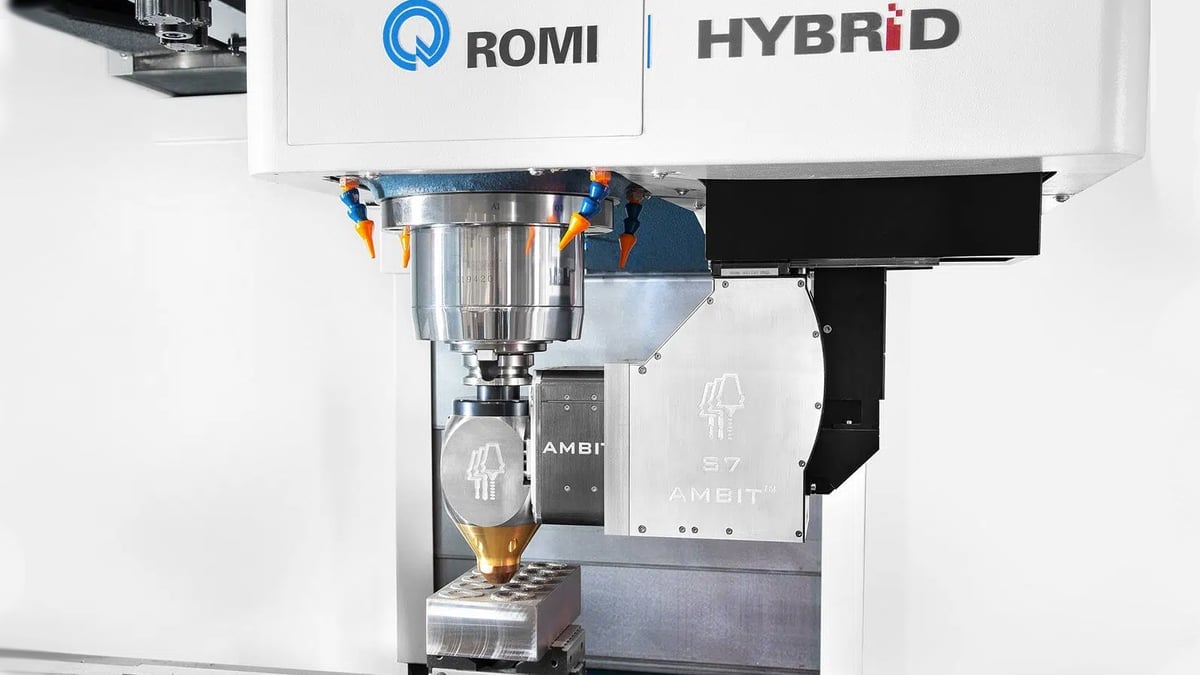
Hybrid manufacturing is a relatively new method that combines additive manufacturing and subtractive manufacturing technology in one machine. These machines use 3D printing to produce the basic, near-net shape of the part in metal or plastic. Then, another unit or tool head mills the part to the required tolerances. As a result, manufacturers (and their customers) have the complex geometries of additive manufacturing and the detailed surface quality of milled components.
In addition to building a part from scratch, these machines are ideal for adding features to existing parts, carrying out repairs of parts, and applying coatings to parts before the machining post process.
Hybrid manufacturing machine operations differ between manufacturers, but they generally fall into two categories:
- Sequential hybrid manufacturing machines complete the full AM sequence first, producing a 3D printed near-net shape part before moving on to the subtractive process.
- Alternating hybrid manufacturing machines, on the other hand, swap between AM and milling units throughout the manufacturing process. Some alternating machines can even machine one part of the component while the AM unit prints another section.
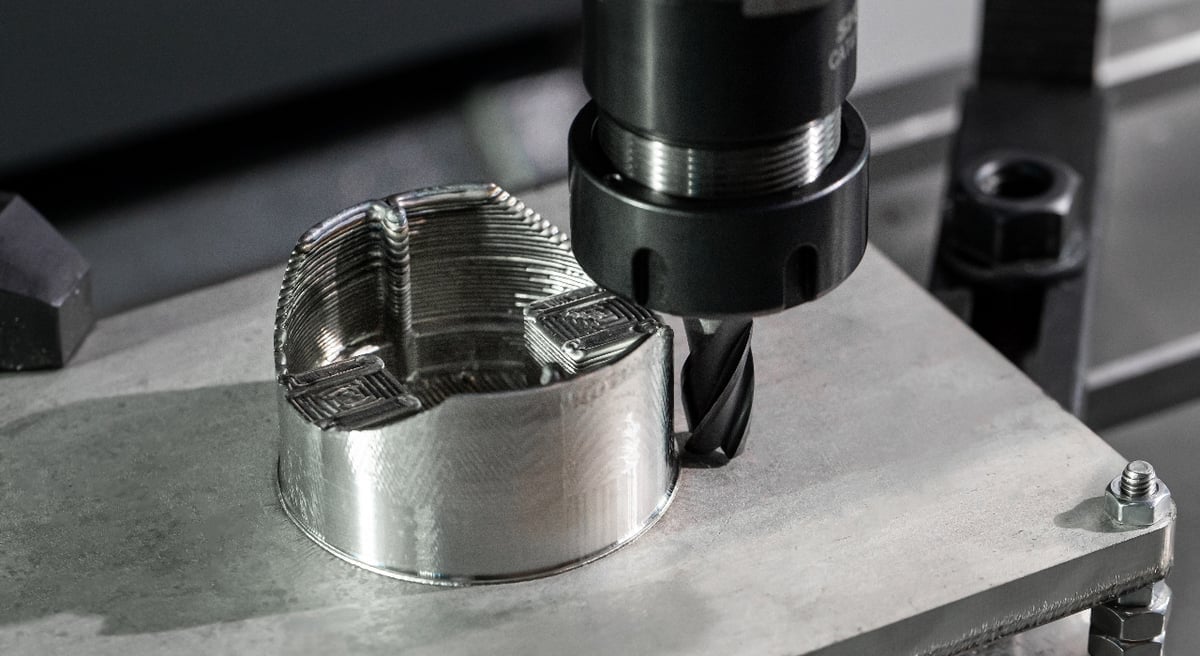
Technically, almost any 3D printing technology could be combined with a CNC machine and there are a few upgrade kits to convert your existing machining units. However, the technology is still developing and the current options are limited to a few combinations. These include:
- DED/CNC: Directed energy deposition (DED) is a metal AM technology where the material — wire or powder — is fed through a narrow nozzle and melted into shape with an electric arc, laser, or electron beam. The advantage of DED is the ability to feed the material from any angle, allowing for 5-axis deposition. This is also used for metal part repair.
- LPBF/CNC: In laser powder bed fusion (LPBF), the machine lays down a thin layer of metal powder, melts the layer’s shape with lasers, and repeats the process until the part is complete. LPBF can, in theory, produce parts without support structures due to the surrounding unfused powder providing the necessary support.
- FDM/CNC: Unlike the previous two methods, fused deposition modeling (FDM) printers melt and extrude metal or thermoplastic filaments or pellets in layers to create the desired geometry. This technology can be much cheaper while still having good strength characteristics (particularly with reinforced polymer filaments), but the parts can require support structures during printing.
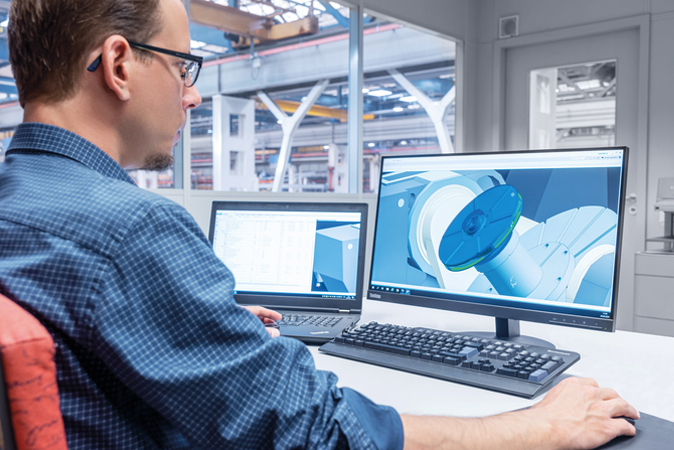
All-In-One Hybrid Software
Ideally, a hybrid manufacturing machine should work with a single round of programming, and most manufacturers aim for simple operability. Some companies produce their own CAD/CAM solutions, although many rely on operating software developed by third parties. Siemens NX, for example, is a popular option among hybrid manufacturing machine manufacturers.
Hybrid manufacturing is a working solution for producing both prototypes and functional end-use parts, in addition to repairing existing components. Hybrid manufacturing is particularly attractive to smaller companies that require both AM and machining capability. These machines can allow them to produce both kinds (or hybrid) parts without investing in two machines. It can also resolve (and has resolved) issues related to part complexity and productivity in demanding, large-scale industries, such as automotive and aerospace.
Pros & Cons of Hybrid Manufacturing Machines

Hybrid manufacturing offers many benefits over pure AM or subtractive methods. One of its most significant advantages is the ability to increase productivity. As both the AM and machining processes can be run in a single machine, there’s no need to swap parts and recalibrate equipment. The machining unit can also partially or completely replace manual AM post-processing, which also speeds up production.
Hybrid manufacturing can achieve higher precision and tighter tolerances than most 3D printers alone. AM creates more complex geometries and part structures than machining can produce, such as part consolidation, internal channels, and lattice-filled walls. Producing the entire part in one machine also reduces the chance of processing flaws or errors. As a result, hybrid parts can perform better and have higher quality.
Hhybrid machines enable you to use multiple materials in a single part, opening the door to significant mechanical performance improvements and cost savings. You can clad weaker parts in stronger metals, add high-performance materials to improve part movement or heat transfer, or save on material costs by using expensive materials only where they’re needed.

Last but not least, hybrid can cut up-front investment and running costs. Instead of purchasing both a CNC machine and an industrial 3D printer, it may be cheaper to buy a hybrid machine. A single hybrid machine also consumes less energy and requires less floor space than separate AM and CNC units.
Despite its great advantages, hybrid isn’t a perfect solution for every manufacturing need. Although these machines can lower initial investment, they are not cheap and may be outside the budgets of smaller companies. Operating hybrid machines can be complicated and requires the operator to have an intricate understanding of both 3D printing and CNC machining to determine the best way to manufacture a given part.
Applications of Hybrid Manufacturing Machines

Hybrid manufacturing is suitable for a great number of industries. Any application that relies on precisely manufactured parts from metals or thermoplastic stands to benefit from hybrid manufacturing technologies. However, some of the sectors that are particularly suitable are these:
- Aerospace: The aerospace industry requires heat-resistant, strong, and lightweight parts with tight tolerances. Hybrid manufacturing can manufacture these components from reinforced thermoplastics and metals like aluminum.
- Automotive: Vehicle engines and chassis contain huge numbers of complex parts. Hybrid manufacturing gives automotive manufacturers to produce these components in a single machine, lowering material and labor costs.
- General Engineering: Maximum uptime is vital for any manufacturing industry. With hybrid manufacturing solutions, it’s possible to repair broken machinery components, which lowers costs and requires less standing inventory.
- Medical: Hybrid manufacturing can help medical professionals create perfectly fitting customized implants, prosthetics, and surgical tools. The AM component allows for part customization, while CNC machining ensures an ideal part quality.
Let’s take a look at a few detailed accounts of how hybrid manufacturing has help manufacturers.
Aerospace
Engineers at the University of Sheffield Advanced Manufacturing Research Center (AMRC) aim to research and develop new ways to advance manufacturing technology. As part of this goal, they’ve designed a novel method to manufacture a critical actuator component for the aerospace industry (pictured above).
These actuators have traditionally been manufactured by machining a solid metal bar into shape. Using a DED/CNC machine, AMRC could change the feedstock part to a tube. By optimally sequencing AM and machining processes, the researchers could add 3D printed metal to the feedstock tube. This approach increased the stability of machining operations and significantly reduced material consumption.
“The use of hybrid manufacture enabled simpler strategies in the machining of features. Hybrid trials have suggested that similar cycle times can be achieved while reducing cost by 23% and providing a large decrease in buy-to-fly ratio from 31:1 to 2.5:1,” explained Nikolaos Tapoglou, a technical fellow in emerging machining technologies at AMRC.
Engineering
Sulzer is a Swiss manufacturer of operations-critical components for the oil & gas and energy sectors, including pumps. Impellers are a vital component for pumps, but they suffer intense wear due to the corrosive liquids that flow through them and need regular replacement. Sulzer has traditionally manufactured impellers using conventional machining, but their complex geometries resulted in extremely long lead times.
By implementing a DMG Mori Lasertec 65 DED/CNC machine, operated using Siemens NX hybrid CAD/CAM software, Sulzer can now build the impellers’ intricate channel structures by alternating between AM and machining methods. The company has cut its lead times 25-fold and can now mill areas that were previously inaccessible, producing parts with high surface quality that improves their efficiency. Additionally, the hybrid machine makes it possible for the company to build larger components than before.
“We are able to reduce the entire lead time from 25 weeks down to less than one,” says Robin Rettberg, head of manufacturing technologies at Sulzer. “We would like to continue to increase capacity in this area as the technology allows us to react even more flexibly to customer requirements.”
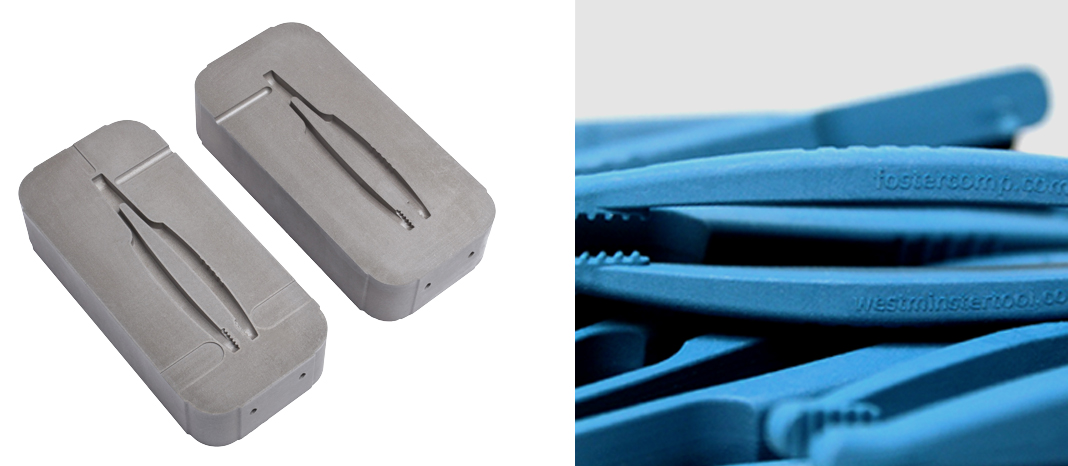
Medical
A global medical equipment manufacturer uses tool steel molds to produce prototype parts in high-temperature plastic. Due to the long lead times on new molds, the company struggled to introduce new products to the market in a timely fashion. It had tried 3D printed plastic mold inserts, but their insulation properties and surface finish limitations resulted in material limitations and inaccuracies between prototypes and final parts. Looking to resolve the issue, the company turned to Mantle P-200 HM machine.
With P-200, the company 3D printed the mold inserts in P2X tool steel material and machined them into the final shape. This methodology resulted in mold inserts with extremely tight (0.001”) tolerances and smooth matte surfaces that didn’t require surface finishing before molding. The molds performed flawlessly in molding temperatures up to 600 °C.
The hybrid process reduced lead times for new molds by more than 80%, from 7 weeks to 8 days. Additionally, the medical company saw manufacturing costs fall by more than 50%.
Top Hybrid CNC/3D Printing Machines
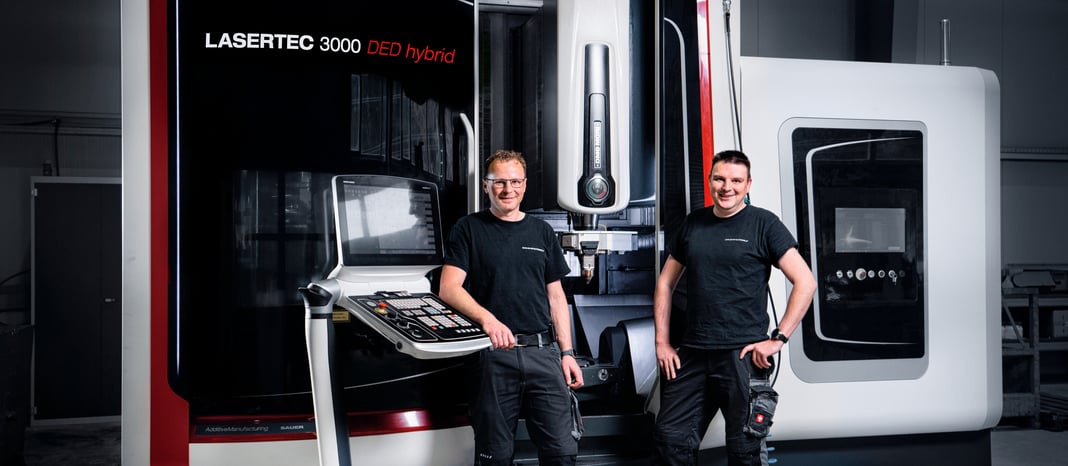
All3DP has compiled this list of some of the current major hybrid manufacturing machines to introduce you to the world of hybrid CNC/3D printing. Compare the machines and choose the one that’s the best fit for your operation.
Zmorph FAB
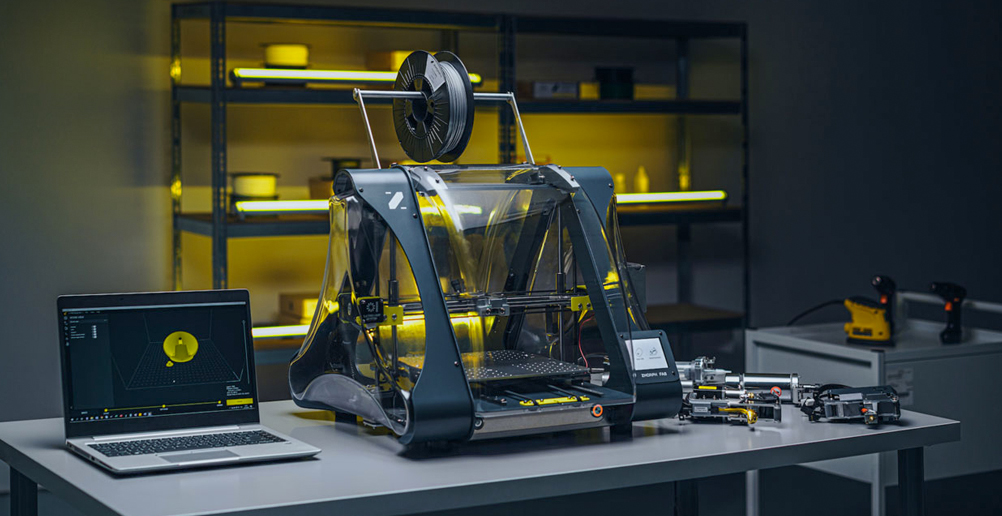
The Zmorph FAB is the smallest hybrid machine on our list. This multitool 3D Printer includes a single or dual extruder 3D printer, a CNC milling tool head, and a thick paste extruder with a wide potential for experimental applications, materials, research, and custom decorations, the company says.
The Zmorph’s all-in-one software for 3D printing and CNC milling, called Voxelizer features a CAM standard workflow for CNC procedures with STEP operations, the ability to change the tool within one G-code, and path visualization.
Zmorph says changing workflows on the Fab is fast with the automatic tool head detection. Although you certainly can machine parts that you’ve 3D printed on the Fab, the focus here is more on the dual use of the single machine, not performing subtractive and additive manufacturing in a single process, like most of the more industrial machines below.
Diabase H-Series
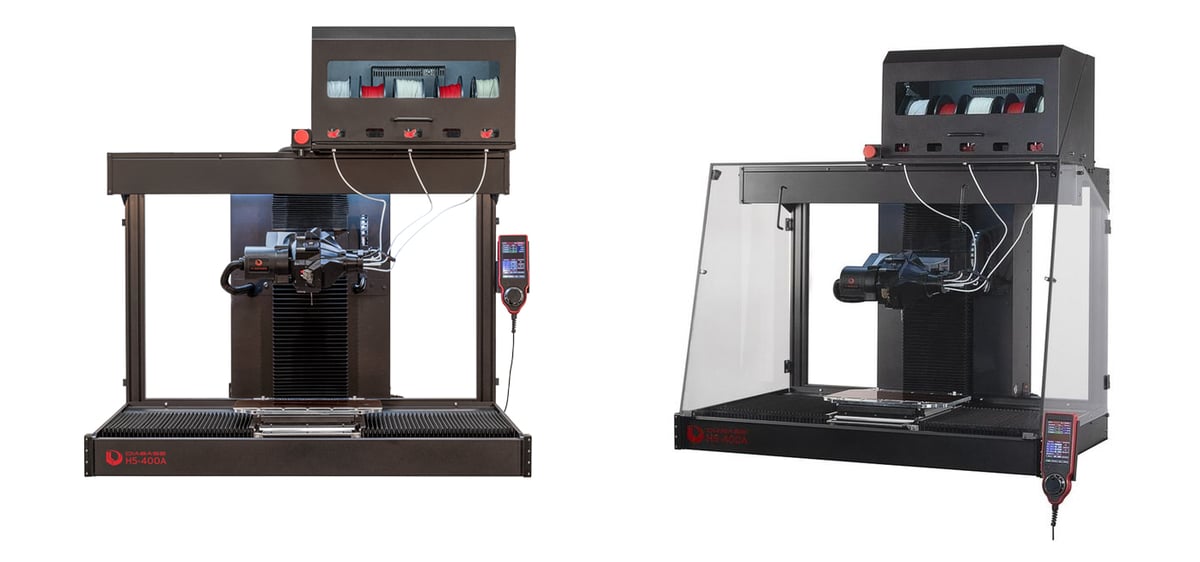
Despite it being called a series, Colorado-based Diabase Engineering’s H-Series currently includes only one machine — the H5-400. But this FDM/CNC milling machine aims high. Diabase’s design goal has been to make the machine as easy to use as possible, enabling one person to operate it with a single computer.
H5-400 features a 5-station automatic tool changer with 14 milling tools and three print heads. An omnidirectional touch probe automates bed compensation, edge detection, and machine calibration. The machine can print any thermoplastics that are suitable for a maximum hot end temperature of 310°C.
The printing nozzles are self-cleaning and priming, enabling H5-400 to combine multiple materials in one print. The machine operates on standard G-code via a web page. As such, operators can use any slicer and CAM package they’re familiar with, further increasing usability.
Namma Eva

French manufacturing start-up company Namma offers the Eva 3-in-1 hybrid manufacturing machine. This large-format machine combines an FDM 3D printer extruder, a CNC milling head, and a laser cutter and engraver. Just swap out the tool heads.
The sheer variety of production options makes Eva a very versatile manufacturing solution. The versatility doesn’t stop there, though. For FDM printing, Eva has two quick-swappable tool heads, one with dual extruders and one for fast printing. The machine supports a wide range of thermoplastics, including ABS-carbon fiber, PLA, Nylon, PC, and TPU.
The 3-axis CNC component also has separate tool heads for soft and durable materials, from wood and plastic to aluminum. Similarly, the laser engraver/cutter has a low- and high-powered tool head options.
The manufacturer claims the tools can be swapped with each other in less than a minute. One person can operate all three manufacturing processes with the N-Play software. With a 1,000 x 500 x 500 mm build volume, Namma EVA is a powerful and flexible hybrid manufacturing machine for plastics.
3D Systems Atlas HS

Titan Robotics has been making the Atlas HS hybrid additive and subtractive machine for some years before being acquired by industry giant 3D systems in 2022. The Atlas prints fast with pellet extrusion and then smooths the part quickly with milling either during or after the printing process while keeping the part on the print bed.
The Atlas HS is designed and built to address the needs of customers in industries including aerospace, automotive, foundry, and consumer products. The hybrid additive and subtractive system on the Atlas HS enables users to quickly and cost-effectively manufacture end-use parts, patterns, molds, tools, jigs, and fixtures on a single machine, the company says.
You can reduce material costs up to 10 times with pellet feedstocks and cut labor costs with automated milling of parts on the print bed, the company says. High-temperature materials include CF-PEI, GF-PEKK, and GF-PC on the Atlas-HS with Titan’s own pellet extrusion system and industrial heated enclosure.
The Atlas-HS incorporates a 3-axis milling system on the same gantry so 3D printed parts can be machined both during and after the printing process. The Atlas HS is also available with dual pellet extruders and a spindle toolhead for dual printing and milling capabilities. See the Atlas and Atlas-H pages for extrusion only options without a spindle.
Sugino Xtended
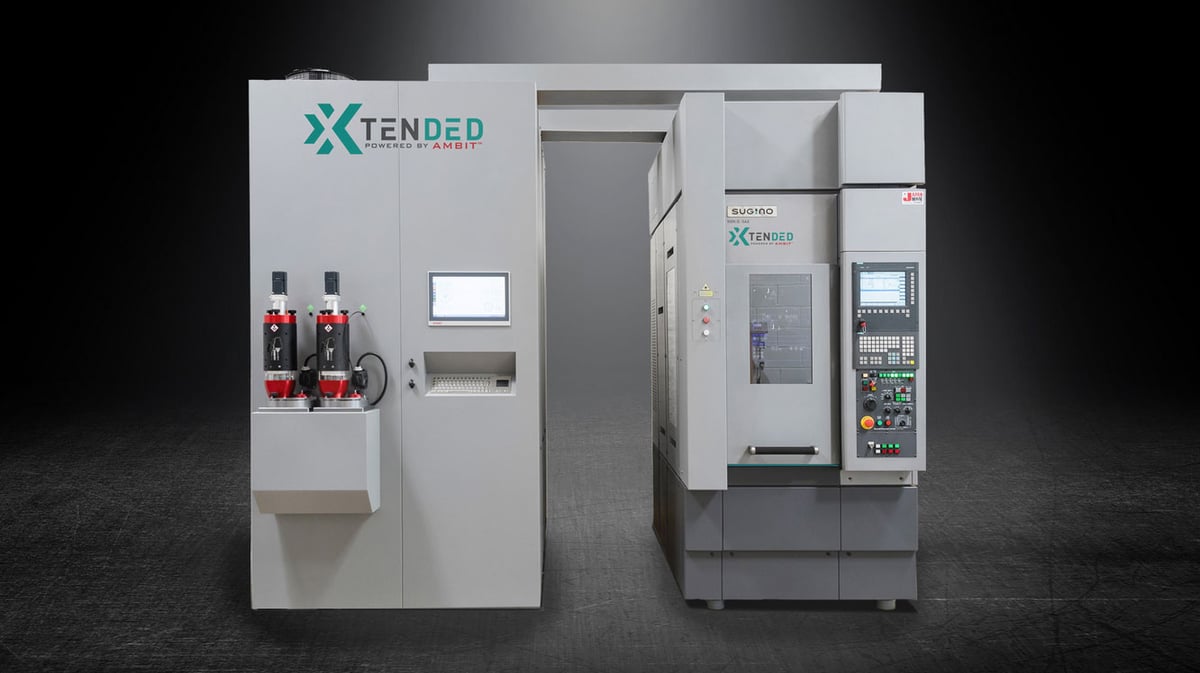
Italy-headquartered Sugino’s Xtended uses powder-based laser metal deposition (LMD) — a form of DED — to 3D print metal parts and components. The platform features a twin-head setup that combines an Ambit (featured below) laser processing head with a 5-axis CNC head with 13 tool options.
The LMD part relies on a 1,064 nm fiber laser and is compatible with Inconel, cobalt alloys, and stainless and tool steels. The standard processing head has a 200-700W power output and 0.8-1.2 mm deposition width, while the optional secondary processing ups the power to 500-1,000W while also increasing depositions width to 1.5 – 2.2 mm.
CNC tooling options can be expanded from 13 to 21 tools. Sugino markets the machine particularly for rapid prototyping and for repairing existing, broken parts and components.
Matsuura Lumex Avance-60
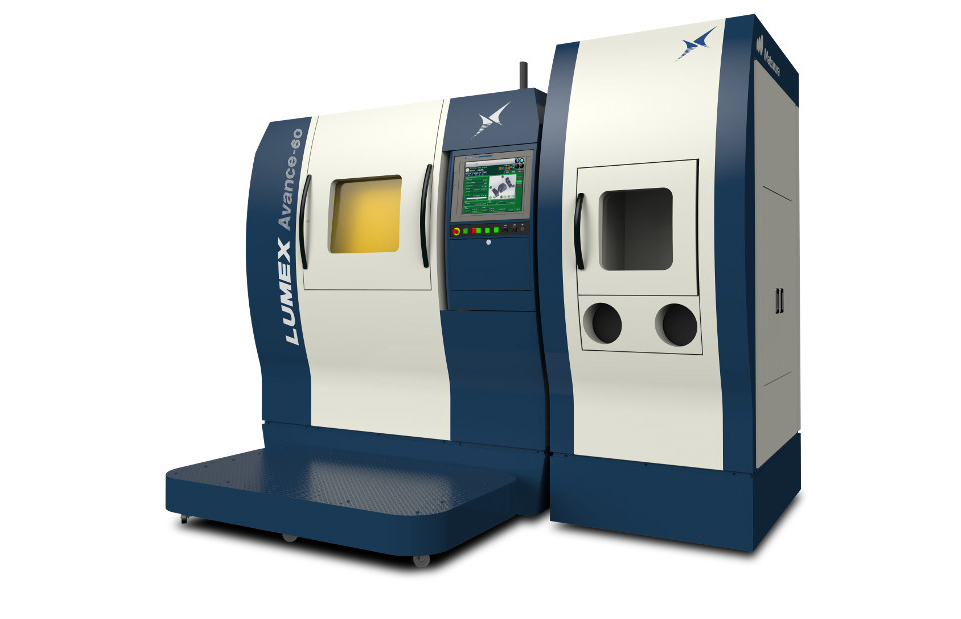
Japanese manufacturer Matsuura was among the first companies to marry additive and subtractive manufacturing commercially in 2002. Its Lumex Avance-60 is a continuation of this legacy.
Lumex Avance-60 features an SLM 3D printer that can work with Matsuura’s metal powders, including stainless steel, cobalt, titanium, aluminum, and nickel alloys, using a 1,000W ytterbium fiber laser.
With a 600 x 600 x 500 mm print volume, the machine can quickly and efficiently print large components, like an entire V8 engine block. It also has an automatic powder recovery system for material recycling. Lumex Avance-60 sports a high-speed milling spindle for CNC machining with 20 tool options. The machine uses Matsuura’s proprietary CAM software to define laser scan and milling paths.
In addition to Lumex Avance-60, Matsuura manufactures the less powerful and more compact Lumex Avance-25 model. This lower-end model features the same tooling options but has less powerful spindle motors and laser. Both models are aimed at a wide range of industries, from prototyping and injection molding to demanding automotive, aerospace, medical, and energy applications.
DMG Mori Lasertec Hybrid

Japanese-German DMG Mori manufactures the Lasertec series of hybrid DED 3D printing CNC milling machines. The Lasertec series includes the Lasertec 65, 125, 3000, and 6600. The 125 is the series’ flagship model, with the others aimed at producing larger or smaller parts.
Each of the machines features a 5-axis coaxial nozzle for metal material deposition and each comes with a 3,000W fiber laser, with the exception of the 6600, which drops the default laser power to 2,000W. They support a wide variety of metal materials, from stainless and tools steel to nickel and copper alloys, cobalt-chrome, and bronze. In 2022, the company added a newly developed blue laser for the hybrid machines. It offers better absorption behavior, which, for example, enables the processing of pure copper.
With the ability to produce parts nearly four meters long (on the 6600), DMG Mori aims the Lasertec series at manufacturing and repairing components in demanding industries. With integrated digitization solutions, the machines are marketed toward aerospace, oil and gas, energy, and engineering fields.
Eco-Hybrid
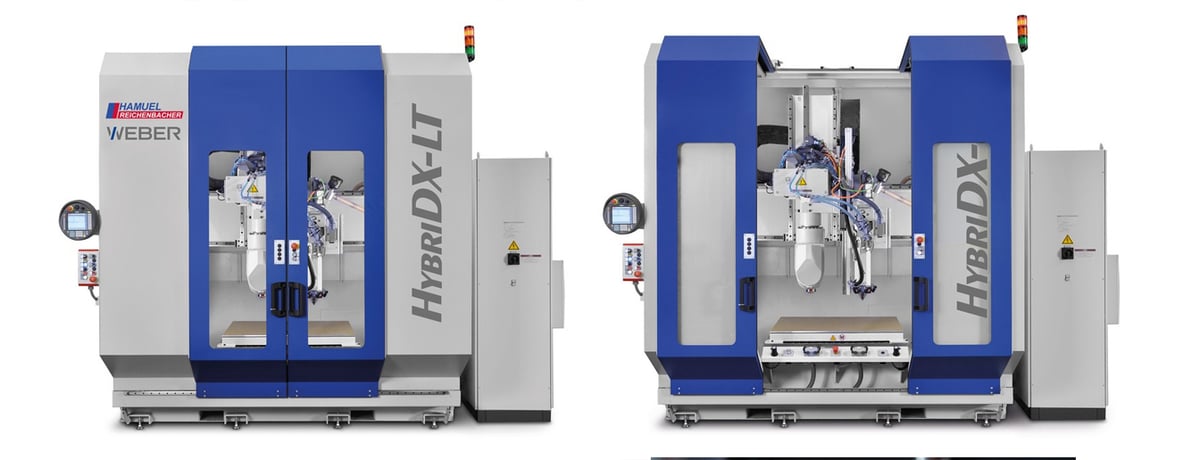
The Hans Weber Eco-Hybrid, available in four sizes, combines fused granular fabrication or FDM printing with pellet material and machining.
The continuous additive printing process permits the production of large-volume and extremely resilient components. After or during printing, 5-axis machining takes place to optimize accuracies and surfaces. This makes the system an ideal choice for the production of rough-shaped components for use as quick prototypes or for the final production of small and large series, the company says.
Because of its size, applications for the largest version include façade elements, formwork for the construction industry or casting molds in mold-making industries. CNC machining perfects their functionality in terms of desired accuracies and high-quality surface finishes.
CEAD BEAD
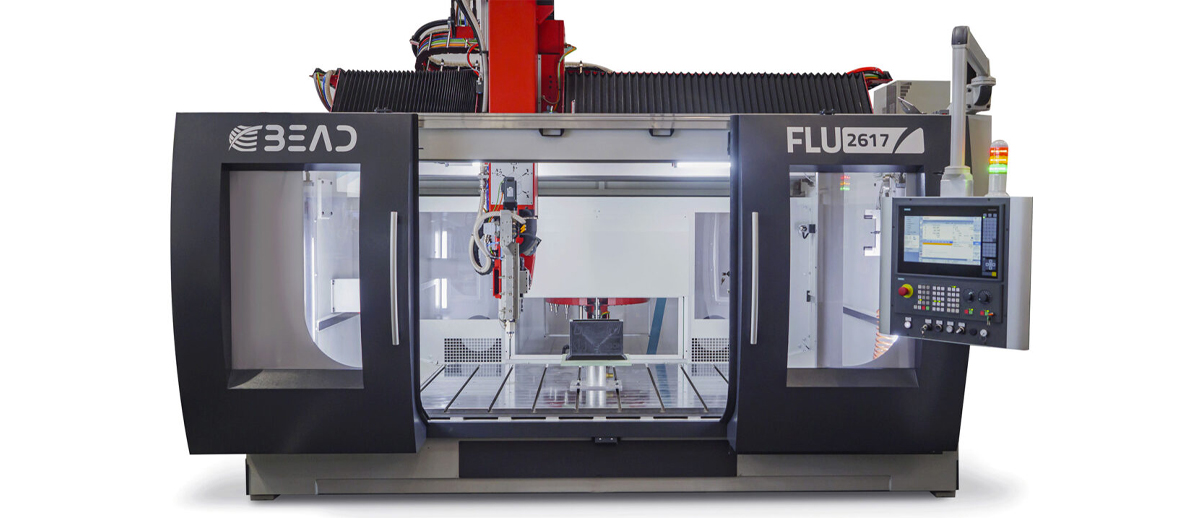
Germany’s CEAD partnered with Italian Belotti in 2021 to harness their respective expertise in additive and subtractive manufacturing. The result of this partnership is the BEAD, a large-format additive manufacturing machine.
The BEAD features a CEAD industrial-grade FDM extruder that consumes polymer pellets. With a maximum nozzle temperature of 400°C, the system can print practically any pelleted thermoplastic, from PP, ABS, and PETG to fiber-reinforced and high-performance materials, such as CF Nylon or PEEK. Combined with Belotti’s 5-axis CNC machining center with 8 to 60 tool change positions, the BEAD offers plenty of versatility.
The machine is available in multiple gantry configurations, which can have dimensions as huge as 50 x 11 x 5 meters. Thanks to the wide material library and huge format, the BEAD is used in aerospace, automotive, and marine industries to produce molds, plugs, and autoclave toolings.
Mazak Integrex i-400 AM
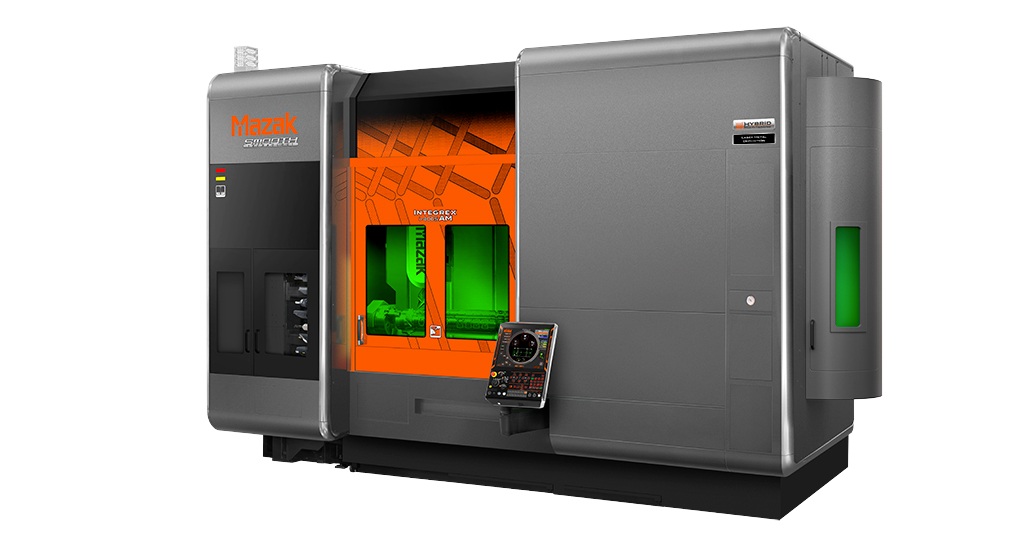
Japan-based Mazak’s Integrex i-400 AM is a 5-axis DED/CNC machine. The company markets the machine as an efficient done-in-one turnkey solution for part processing.
Integrex i-400 AM melts metal powders with a fiber laser. Mazak says the machine is capable of joining multiple metal materials into one part, enabling the repair of demanding components like turbine blades. An automatic tool changer loads high-speed or high-accuracy tool heads into the CNC machine based on the used material and system attributes.
Mazak also offers the Integrex i-400S AM version of the machine. This upgrade adds a second turning spindle and milling spindle to minimize the need for fixtures, tools, and handling.
Optomec Lens Machine Tool Systems
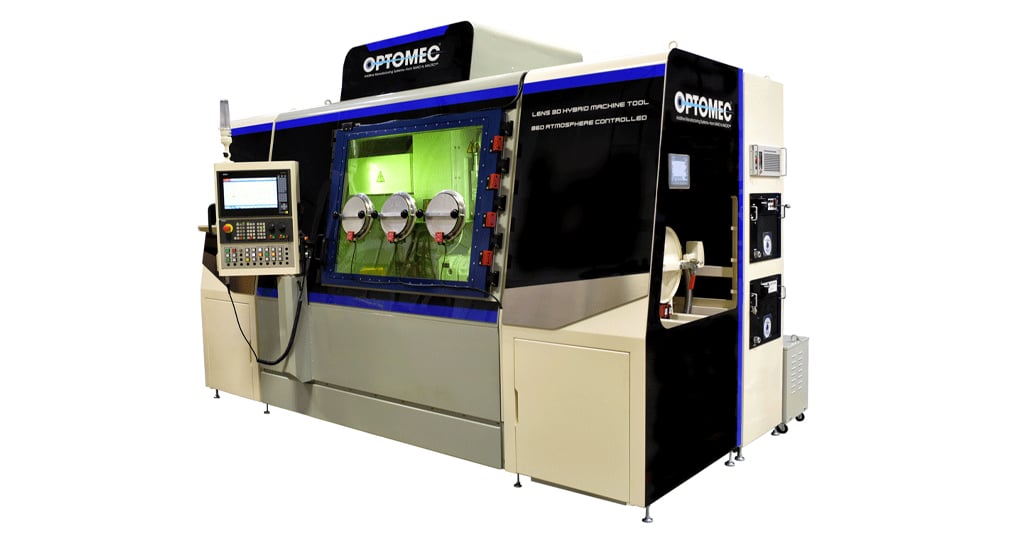
Optomec, headquartered in New Mexico, is a veteran in the additive manufacturing field, having been established in 1997. The company produces Lens 860 Machine Tool Systems (MTS) that combine a DED metal printer and CNC milling. The MTS machine has two versions with an open or controlled atmosphere.
Both machines offer the same productivity with a 3kW laser, four powder feeders, and a 16-tool ATC. They come standard with a 3-axis motion system, but can optionally be upgraded to 4- or 5-axis systems. Both Lens machines use a Siemens controller with proprietary Optomec software.
The Controlled Atmosphere System features a hermetically sealed build chamber and closed loop atmosphere controls, while the Open Atmosphere System is restricted to the general atmosphere. Both can print Inconel, steel, cobalt, and tungsten, although the Controlled system is likely to have a higher part quality. The machines are also available as additive-only versions.
Mantle P-200
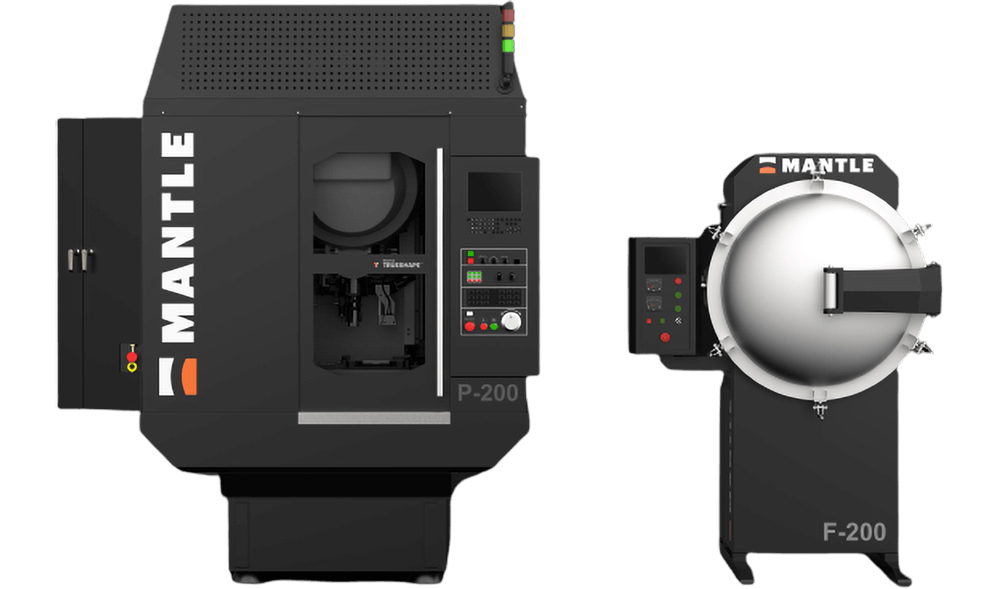
Californian start-up company Mantle produces a unique hybrid manufacturing machine with a narrow focus on mold and toolmaking. Mantle’s P-200 uses a proprietary metal extrusion 3D printing technology dubbed the TrueShape process. P-200 combines this process with high-accuracy CNC tooling in one machine.
The TrueShape method resembles FDM but uses Mantle’s metal paste materials, including the P2X and H13 tool steels. The pastes are extruded in layers, dried, and then CNC machined for higher accuracy and improved surface finish. Finally, the parts must be sintered into dense steel components in a high-temperature furnace, like Mantle’s F-200.
This proprietary process gives components extremely high detail accuracy and layer line-free, high-quality surfaces, says Mantle. P-200 can produce detailed molds and dies for medical and consumer goods production. Mantle’s software automatically determines the best additive and subtractive toolpath strategy for each part.
Meltio Hybrid Engine
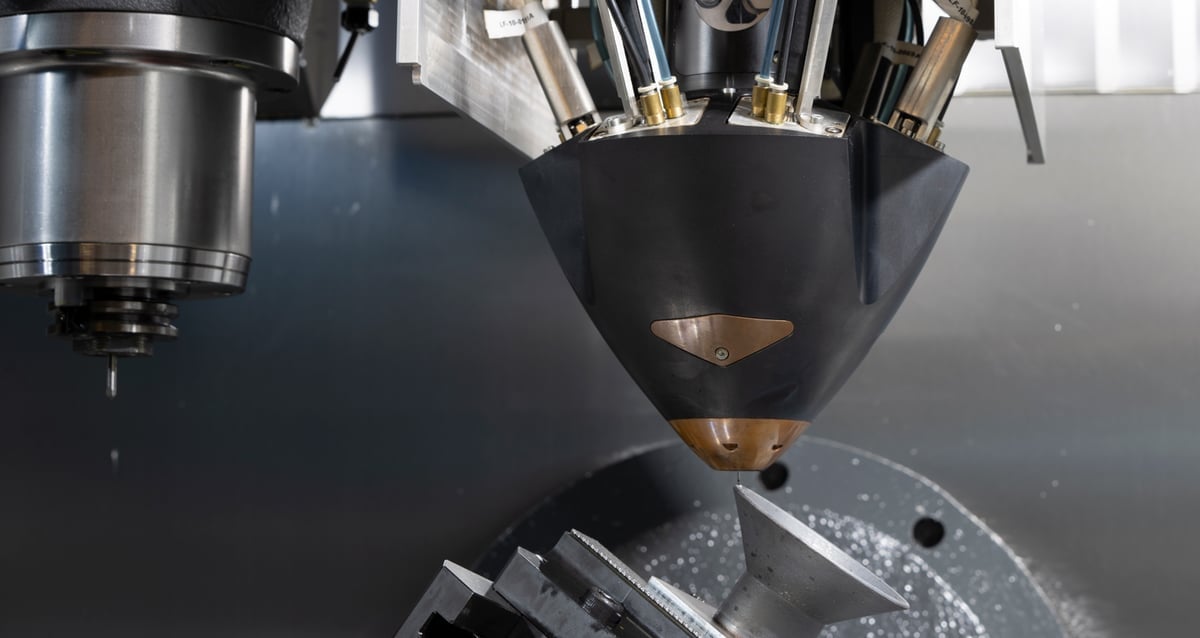
Spanish metal 3D printer maker, Meltio offers a CNC integration unit called the Meltio Engine that can turn almost any industrial CNC machine or robotic platform into a hybrid metal manufacturing system with no inherent size constraints. By retrofitting your existing CNC machine, you’ll have a new capability to conduct cost-effective component creation, repair, part augmentation, and feature addition on metal parts, the company says.
The Meltio system is a directed energy deposition (DED) process that precisely stacks weld beads on top of one another in wire form when introduced into the laser-generated melt pool. Meltio’s technology comes packaged in a compact deposition head with six low-power lasers that are capable of processing metal welding wire fed coaxially. The head is mounted next to the CNC milling machine spindle mount.
The system can process the metal wire many shops may already have on hand for even more savings. The $165,000 to $185,000 price tag excludes the CNC machine. The total CNC machine plus Meltio head integration and accessories can run up to $245,000. If you are not keen to retrofit your CNC machine, you can buy a Haas CNC with a Meltio already installed through Phillips Corporation.
Hybrid Manufacturing Technologies Ambit
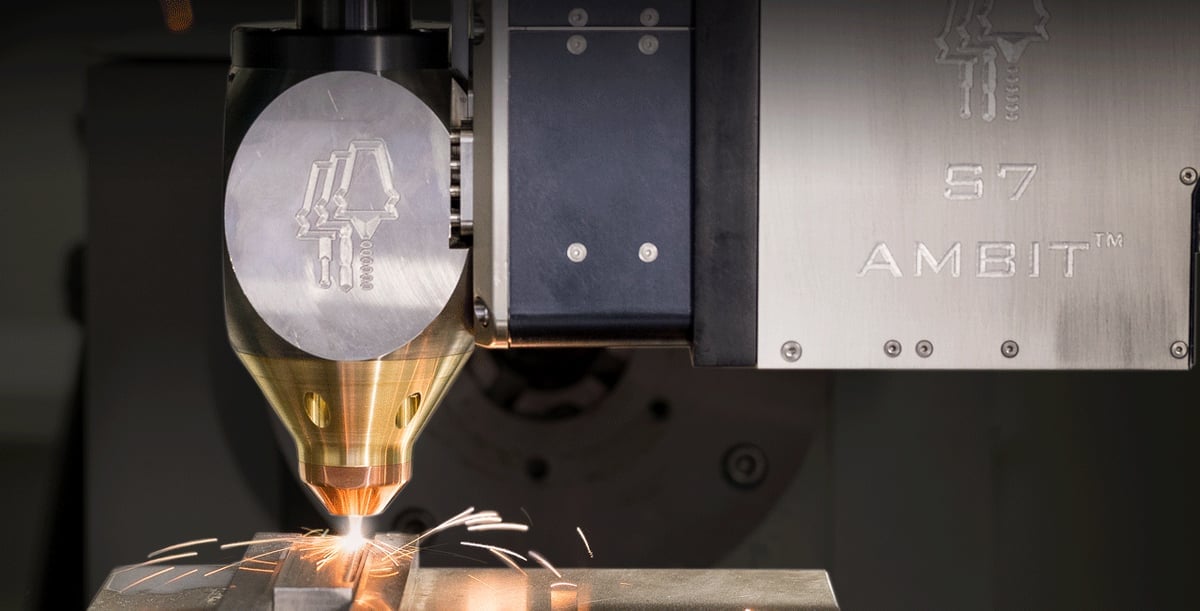
Another company that can retrofit your existing machine tools with additive is the aptly named US-based Hybrid Manufacturing Technologies (HMT). “Hybrid all-in-one machines significantly reduce capital costs and provide an intuitive adoption path for CNC operators,” the company says. In fact, their offering is the most versatile on our list, unifying multiple complementary technologies in one setup.
The company offers its patented Ambit tool-changeable laser cladding heads or an extrusion head with a docking system that can upgrading almost any CNC machine with laser metal deposition or FDM.
The company says its technology is ideal for repairing high-value metal components and adding features to existing parts. HMT can upgrade existing vertical platforms to enable both additive and subtractive machining capabilities in one system or create bespoke solutions with customized heads to meet the user’s objectives.
The Sugino’s Xtended hybrid machine listed above is based on the Ambit tool set.
License: The text of "3D Printing & CNC: A Guide to the Best Hybrid 3D Printers" by All3DP Pro is licensed under a Creative Commons Attribution 4.0 International License.